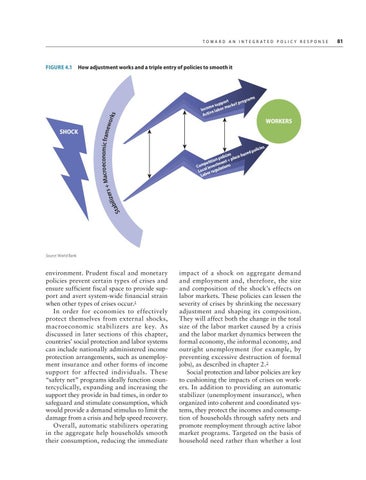T o w a r d a n I n t e g r a t e d P o l i c y R e s p o n s e
FIGURE 4.1 How adjustment works and a triple entry of policies to smooth it
s
SHOCK
acroeconomic framew rs + M orks e z i l bi a t S
ram
rog ort upp arket p me s m Inco e labor v Acti
WORKERS
cies poli sed s a e b i c poli + place t tion peti estmen ns m o C l inv gulatio a c o L or re Lab
Source: World Bank
environment. Prudent fiscal and monetary policies prevent certain types of crises and ensure sufficient fiscal space to provide support and avert system-wide financial strain when other types of crises occur.1 In order for economies to effectively protect themselves from external shocks, macroeconomic stabilizers are key. As discussed in later sections of this chapter, countries’ social protection and labor systems can include nationally administered income protection arrangements, such as unemployment insurance and other forms of income support for affected individuals. These “safety net” programs ideally function countercyclically, expanding and increasing the support they provide in bad times, in order to safeguard and stimulate consumption, which would provide a demand stimulus to limit the damage from a crisis and help speed recovery. Overall, automatic stabilizers operating in the aggregate help households smooth their consumption, reducing the immediate
impact of a shock on aggregate demand and employment and, therefore, the size and composition of the shock’s effects on labor markets. These policies can lessen the severity of crises by shrinking the necessary adjustment and shaping its composition. They will affect both the change in the total size of the labor market caused by a crisis and the labor market dynamics between the formal economy, the informal economy, and outright unemployment (for example, by preventing excessive destruction of formal jobs), as described in chapter 2. 2 Social protection and labor policies are key to cushioning the impacts of crises on workers. In addition to providing an automatic stabilizer (unemployment insurance), when organized into coherent and coordinated systems, they protect the incomes and consumption of households through safety nets and promote reemployment through active labor market programs. Targeted on the basis of household need rather than whether a lost
81

